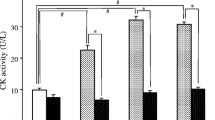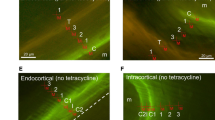Abstract
We have previously shown that alendronate, a potent bisphosphonate compound, can prevent human PC-3 ML tumor cell metastasis to the bone (Stearns and Stearns, 1996, Oncol Res, 8, 69-75). In this paper, tumor cells were injected into the bone medullary cavity of SCID mice femurs both in vivo and following isolation in vitro. ELISAs showed that the amount of collagen I released in the bone marrow (i.e. in in vitro experiments) and the blood plasma (i.e. in in vivo experiments) was a function of the time of incu-bation or the number of cells injected in the femurs. ELISAs also showed that the levels of matrix metal-loproteinase (MMP-2 and MMP-9) secreted in the bone medullary cavity of the femurs directly correlated with the extent of collagen 1 release. In vitro experiments carried out with ‘live’ and ‘devitalized bone’ yielded similar results suggesting that the tumor cells (not the osteoclasts) were primarily responsible for the bone solubilization observed. Alendronate pretreatment of the SCID mice (0.1 mg/kg biweekly for 3 weeks) (or the tumor cells) blocked both MMP production by the tumor cells (and the osteoclasts) and collagen I release, providing direct evidence that alendronate might be utilized to prevent bone destruction by metastatic tumor cells. Zymography indicated that MMP-2 activation might be responsible for bone solu-bilization. In addition, the data suggest that the plasma levels of collagen I might be a marker of bone metastasis and osteolysis.© Kluwer Academic Publishers 1998
Similar content being viewed by others
References
Berrettoni BA and Carter JR, 1986, Mechanisms of cancer metastasis to bone. J Bone Joint Surg, 68, 308-12.
Martin TJ and Mundy GR, 1987, Hypercalcemia of malignancy. In: Martin TJ and Raisz LG, eds. Clinical Endocrinology of Calcium Metabolism. New York: Marcel Dekker, pp. 171-99.
Nemoto R, Satou S, Miyagawa I and Koiso K, 1991, Inhibition by a new bisphosphonate (AHBuBP) of bone resorption induced by the MBT-2 tumor of mice. Cancer, 67, 643-8.
Manishen WJ, Sivananthan K and Orr FW, 1986, Resorbing bone stimulates tumor cell growth. A role for the host microenvironment in bone metastasis. Am J Pathol, 123, 39-45.
Canfield R, Rosner W, Skinner J, et al.1977, Diphosphonate therapy of Paget’s disease of bone. J Clin Endocr Metab, 44, 96-106.
Fleisch H, 1987, Bisphosphonates - history and experimental basis. Bone, 8, 523-8.
Frijlink WB, Bijvoet OLM, de Veide J and Heynen G, 1979, Treatment of Paget’s disease with (3-amino-1-hydroxypropylidene)-1, 1-bisphosphonate (APD). Lancet, 1, 799-803.
Merlini G, Parrinello GA, Piccinini L, et al., 1990, Long-term effects of parenteral dichloromethylene bisphosphonate (CL2MBP) on bone disease of myeloma patients treated with chemotherapy. Hematol Oncol, 3, 23-30.
Russel RGG, Smith R, Preston CJ, et al.1974, Diphosphonates in Paget’s disease. Lancet, 1, 894-8.
Sanchez-Sweatman P, Khoka R, Singh G and Orr FW, 1996, Mechanisms of cancer cell mediated osteolysis. In: Orr GE and Singh F, eds. Bone Metastasis Mechanisms and Pathophysiology. Austin, TX: R.G. Landes Co., pp. 123-32.
Smith R, Russel RGG and Bishop M, 1971, Diphosphonates and Paget’s disease of bone. Lancet, 1, 945-7.
Attardo-Parrinello G, Merlini G, Pavesi F, et al.1987, Effects of a new aminodiphosphonate in patients with osteolytic lesions from metastases and myelomatosis. Arch Intern Med 147, 1629-33.
Elomaa I, Blomquist C, Porkka L, et al.1988, Clodronate for osteolytic metastases due to breast cancer. Biomed Pharmacother, 42, 111-16.
Hall DG and Stoica G, 1994, Effect of the bisphosphonate risedronate on bone metastases in a rat mammary adenocarcinoma model system. J Bone Min Res, 9, 221-30.
Morton AR, Cantrill JA, Pillai GV, et al.1992, Sclerosis of lytic bone metastases after disodium aminohydroxypropylidene bisphosphonate (APD) in patients with breast carcinoma. Br Med J, 297, 772-3.
Van Holten-Verzantvoort A, Bijvoet OLM, Cleton FJ, et al. Reduced morbidity from skeletal metastases in breast cancer patients during long-term bisphosphonate (APD) treatment. Lancet, II, 983-5.
Rodan GA and Fleisch HA, 1996, Bisphosphonates: mechanisms of action. J Clin Invest, 97, 2692-6.
Cleton FJ, van Holten-Verzantvoort AT and Bijvoet OLM, 1989, Effect of long-term bisphosphonate treatment on morbidity due to bone metastases in breast cancer patients. In: Brunner KW, Fleisch H and Senn H-J, eds. Bisphosphonates and Tumor Osteolysis. Rec Progr Cancer Res.Springer-Verlag, 116, 73-78.
Elte JWF, Bijvoet OLM, Cleton FJ, et al.1986, Osteolytic bone metastases in breast carcinoma pathogenesis, morbidity and bisphosphonate treatment. Eur J Cancer Clin Oncol, 22, 493-500.
Fitton A and McTavish D, 1991, Pamidronate. A review of its pharmacological properties and therapeutic efficacy in resorptive bone disease. Drugs, 41, 289-318.
Guaitani A, Sabatini M, Polentarutti N, et al.1985, Effects of disodium etidronate on tumor-induced hypercalcemia, bone invasion, and metastasis in rodents. In: Garattini, S, ed. BoneResorption, Metastasis, and Diphosphonates. New York: Raven Press, pp. 51-8.
Jung A, Bornand J, Mermillod B, et al.1984, Inhibition by diphosphonates of bone resorption induced by the Walker tumor of the rat. Cancer Res, 44, 3007-11.
Shevrin DH, Gorny KI, Rosol TJ and Kukreja SC, 1991, Effect of etidronate disodium on the development of bone lesions in an animal model of bone metastasis using the human prostate cancer cell line PC-3. Prostate, 19, 149-54.
Clarke NW, McClure J and George NJ, 1992, Disodium pamidronate identifies differential osteoclastic bone resorption in metastatic prostate cancer. Br J Urol, 69, 64-70.
Averbuch SD, 1992, New bisphosphonates in the treatment of bone metastases. Cancer, 72, 3443-52.
Stearns ME and Wang M, 1996, Effects of alendronate and taxol on PC-3 ML cell bone metastases in SCID mice. Invas Metas, 16, 116-31.
Stearns ME, 1998, Alendronate blocks TGF-b stimulated matrix metalloproteinase-2 production by human prostate PC-3ML cells and collagen I degradation in vitro. Clin Exp Met (in press).
Nakajima M, Custead SE, Welch Dr and Nicolson G, 1984, Type IV collagenolysis: relation to metastatic properties of rat 13762 mammary adenocarcinoma metastatic cell clones. AACR Proc, 224, 162.
Wang M and Stearns ME, 1991, Isolation and characterization of PC-3 human prostatic tumor sublines which preferentially metastasize to select organs in SCID mice. Differentiation, 48, 115-25.
Wang M, Fudge K, Rhim JS and Stearns ME, 1996, Cytokine regulation of the matrix metalloproteinases and their inhibitors in HPV-18 transformed human prostatic tumor cell lines. Oncol Res, 8, 303-15.
Stearns M and ME Stearns, 1996, Evidence for increased activated metalloproteinase 2 (MMP-2a) expression associated with human prostate cancer progression. Oncol Res, 8, 69-75.
Bradford MM, 1976, A rapid and sensitive method for the quantitation of microgram quantities of protein utilizing the principles of protein-dye binding. Anal Biochem, 72, 248-54.
Levy AT, Cioce V, Sobel ME, et al., 1991, Increased expression of the mr 72,000 type IV collagenase in human colonic adenocarcinoma. Cancer Res, 51, 439-44.
Tarin D, Hoyt BJ and Evans DJ, 1982, Correlation of collagenase secretion with metastatic colonization potential in naturally occurring murine mammary tumors. Br J Cancer, 46, 266-78.
D’Errico A, Garbisa S, Liotta LA, et al.1991, Augmentation of type IV collagenase, laminin receptor, and Ki67 proliferation antigen associated with human colon, gastric and breast carcinoma progression. Mod Pathol, 4, 239-42.
Hewitt RE, Leach IH, Powe DG, et al.1991, Distribution of collagenase and tissue inhibitor of metalloproteinases (TIMP) in colorectal tumours. Int J Cancer, 49, 666-72.
Irimura T, Yamora T, Bennett SC, et al.1987, The relationship of collagenolytic activity to stage of human colorectal carcinoma. Int J Cancer, 40, 24-31.
Thiebaud D, Leyvraz S, von Fliedner V, et al.1991, Treatment of bone metastases from breast cancer and myeloma with pamidronate. Eur J Cancer, 27, 37-41.
Lorenzo JA, Pilbeam CC, Kalinowski JF and Hibbs MS, 1992, Production of both 92 and 72 KDa gelatinases by bone cells. Matrix, 12, 282-90.
Monteagudo C, Merino MJ, San-Juan J, et al.1990, Immuno-histochemical distribution of type IV collagenase in normal, benign and malignant breast tissue. Am J Pathol, 136, 585-92.
Van Der Stappen JWJ, Hendriks T and Wobbes T, 1990, Correlation between collagenolytic activity and grade of histological differentiation in colorectal tumours. Int J Cancer, 45, 1071-8.
Stearns ME and Wang M, 1993, Type IV collagenase (Mr 72,000) expression in human prostate: benign and malignant tissue. Cancer Res, 53, 878-83.
Baron R, 1995, Molecular mechanisms of bone resorption. Acta Orthop Scand, 266, 66-70.
Carano A, Teitelbaum SL, Konsek JD, et al.1990, Bisphosphonates directly inhibit the bone resorption activity of isolated avian osteoclasts in vitro. J Clin Invest, 85, 456-61.
Everts V, Delaisse J-M, Korper W, et al.1992, Degradation of collagen in the bone resorbing compartment underlying the osteoclast involves both cysteine-proteinases and matrix metalloproteinase. Cell Physiol, 150, 221-31.
Hill PA, Docherty AJP, Bottomley KMK, et al.1995, Inhibition of bone resorption in vitroby selective inhibitors of gelatinase and collagenase. Biochem J, 308, 167-75.
Chambers TJ and Fuller K, 1987, Generation of osteoclast cultures of rabbit bone marrow and spleen cells. J Cellular Physiol, 132, 441-52.
Meikle MC, Bord S, Hembry RM, et al.1992, Human osteoblasts in culture synthesize collagenase and other matrix metalloproteinases in response to osteotropic hormones and cytokines. J Cell Sci, 103, 1093-99.
Rifas L, Halstead LR, Peck WA, et al.1989, Human osteoblasts in vitrosecrete tissue inhibitor of metalloproteinases and gelatinase but not interstitial collagenase as major cellular products. J Clin Invest, 84, 686-94.
Denhardt DT, Feng B, Dylan RE, et al.1993, Tissue inhibitor of metalloproteinases (TIMP, aka EPA): structure, control of expression and biological functions. Pharmac Ther, 59, 329-41.
Heath JK, Atkinson SJ, Meikle MC and Reynolds JJ, 1984, Mouse osteoblasts synthesize collagenase in response to bone resorbing agents. Biochim Biophys Acta, 802, 151-4.
Murphy G, McAlpine CG, Poll CT and Reynolds JJ, 1985, Purification and characterization of a bone metalloproteinase that degrades gelatin and types IV and V collagen. Biochim Biophys Acta, 831, 49-58.
Otsuka K, Sodek J and Limeback H, 1984, Synthesis of collagenase and collagenase inhibitors by osteoblast-like cells in culture. Eur J Biochem, 145, 123-9.
Shimizu H, Sakamoto M and Sakamoto S, 1990, Bone resorption by isolated osteoclasts in living versus devitalized bone: differences in mode and extent and the effects of human recombinant tissue inhibitor of metalloproteinase. J Bone Miner Res, 5, 411-18.
Teronen O, Konttinen YT, Lindqvist C, et al.1997, Inhibition of matrix metalloproteinase-1 by dichloromethylene bisphosphonate (clodronate). Calcif Tissue Int, 61, 59-61.
Author information
Authors and Affiliations
Rights and permissions
About this article
Cite this article
Stearns, M.E., Wang, M. Alendronate blocks metalloproteinase secretion and bone collagen I release by PC-3 ML cells in SCID mice. Clin Exp Metastasis 16, 693–702 (1998). https://doi.org/10.1023/A:1006524610591
Issue Date:
DOI: https://doi.org/10.1023/A:1006524610591




